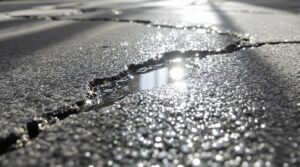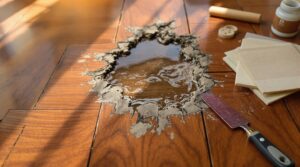Hardwood floor cupping occurs when moisture imbalances cause floorboard edges to rise higher than their centers, creating a concave shape. Common causes include high humidity, subfloor moisture, and improper installation. Professional repairs typically cost $3-8 per square foot, with severe cases reaching $100 per square foot. Solutions range from moisture control and dehumidification to sanding and refinishing. Understanding the specific cause and damage extent determines the most effective restoration approach.
Key Takeaways
- Cupping occurs when floorboard edges rise higher than centers due to moisture imbalances, creating a concave or wavy appearance across the floor.
- Main causes include high humidity, subfloor moisture, improper installation, and delayed response to spills or water damage.
- Professional repair costs range from $3-$8 per square foot for standard repairs, potentially reaching $100 per square foot for severe damage.
- Fixing cupped floors involves moisture measurement, gradual drying to 6-9% moisture content, sanding, and applying urethane finish.
- Prevention requires maintaining 30-50% relative humidity, using proper cleaning products, and promptly addressing spills or water exposure.
Understanding Hardwood Floor Cupping
Hardwood floor cupping represents a significant concern for homeowners and contractors alike, characterized by the edges of floorboards rising higher than their centers to create a distinctive concave shape.
This condition manifests as a wavy or rippled appearance across flooring materials, often accompanied by visible gaps between boards in severe cases.
The primary catalyst for cupping is moisture control issues, particularly when there's an imbalance in humidity levels affecting the wood. This issue is distinctly different from crowning in boards, which occurs when the center rises above the edges.
Early detection is possible by observing how light reflects off the floor surface, revealing subtle shadows where board edges have begun to rise.
Seasonal variations in humidity can trigger this problem, especially during shifts between humid summers and dry winters.
Understanding these fundamentals is essential for implementing effective prevention strategies and maintaining the structural integrity of hardwood floors.
Common Causes of Cupped Wood Floors
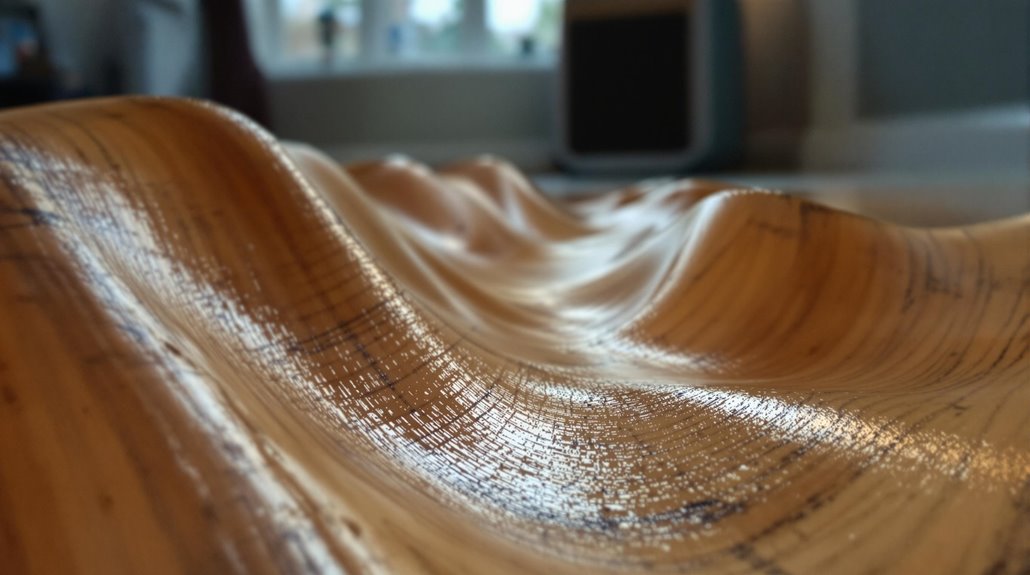
Moisture stands at the forefront of factors causing wood floor cupping, with both environmental conditions and maintenance practices playing vital roles in this deformation process. Environmental awareness and proper moisture control are essential, as humidity fluctuations can cause wood expansion and contraction. Installation errors and subfloor conditions greatly contribute to cupping issues. Since hardwood is naturally hygroscopic material, it readily absorbs moisture from its surroundings, making proper environmental control crucial.
| Factor | Impact |
|---|---|
| Humidity Changes | Causes expansion/contraction |
| Subfloor Moisture | Affects bottom board moisture |
| Installation | Proper acclimation needed |
| Maintenance | Affects moisture balance |
Maintenance-related issues, including improper cleaning methods and delayed spill response, can exacerbate cupping problems. Regular moisture monitoring using appropriate meters helps detect potential issues early. Basement and crawl space moisture management, alongside proper ventilation, remains vital for preventing wood floor deformation, particularly in areas prone to high humidity or seasonal changes.
Signs and Symptoms of Floor Cupping
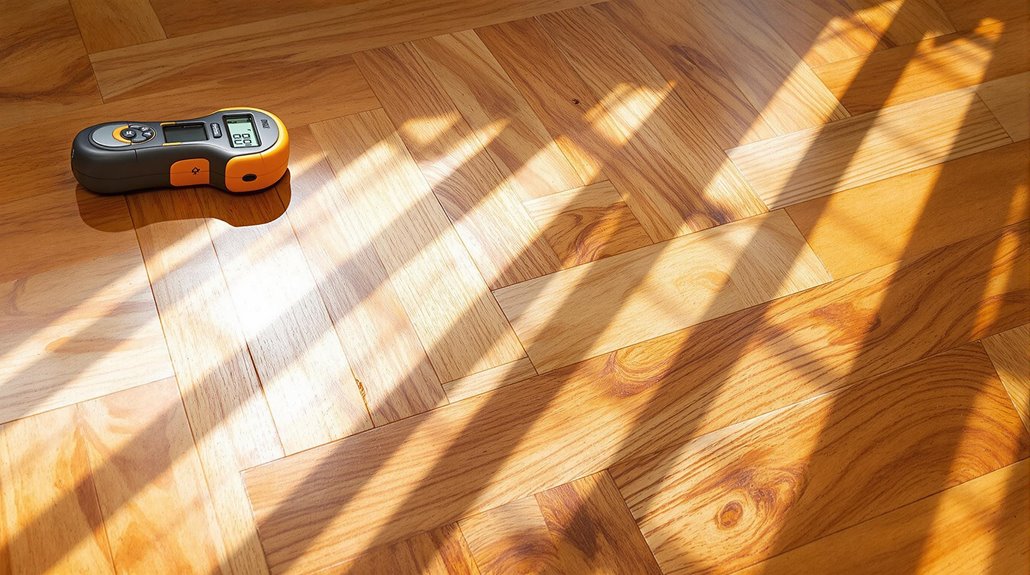
Floor cupping manifests through distinct visual indicators, primarily characterized by raised edges along floorboards that create a concave or "U" shape across each plank.
Early detection relies on observing uneven light reflection patterns across the floor surface and the appearance of slight shadows where board edges elevate higher than their centers. If left unaddressed, these symptoms can progress to severe board separation and potential safety hazards.
Professional assessment often includes measuring the severity of floor deformation using moisture meters and systematic visual inspections from multiple angles to evaluate the extent of cupping damage.
Visual Clues of Cupping
The telltale signs of hardwood floor cupping manifest through distinct visual indicators that become progressively more apparent over time. During initial damage assessment, homeowners may notice slightly raised edges on individual planks and uneven light reflection across the surface. When viewed from a low angle, the flooring exhibits a distinctive bowing effect, with the center appearing lower than the edges.
| Visual Indicator | Severity Level |
|---|---|
| Raised Edges | Early Stage |
| Uneven Light Reflection | Early Stage |
| Visible Gaps Between Boards | Moderate Stage |
| Concave Plank Shape | Advanced Stage |
| Splintering/Cracking | Severe Stage |
As moisture imbalance persists, these visual cues intensify, leading to more pronounced concave shapes, wider gaps between boards, and potential irreversible warping of the hardwood planks.
Measuring Floor Deformation
Accurately measuring hardwood floor deformation requires systematic assessment using both traditional and modern methodologies.
Professional measurement techniques include geodesic levelling, direct deflection measurements, and automated spatial systems. Each method serves specific assessment purposes in determining the extent of floor cupping.
Traditional approaches utilize precise levelling techniques with benchmarks at strategic points, particularly at room corners, while electronic spirit levels provide quick slope measurements.
More advanced deformation assessment methods incorporate ground laser scanning and automated tacheometric measurements, offering thorough data collection across the entire floor surface.
For continuous monitoring, specialized sensors such as clinometers and extensometers can track structural behavior over time.
The combination of these measurement techniques guarantees accurate documentation of floor cupping severity and progression.
Measuring Moisture Content and Damage Assessment
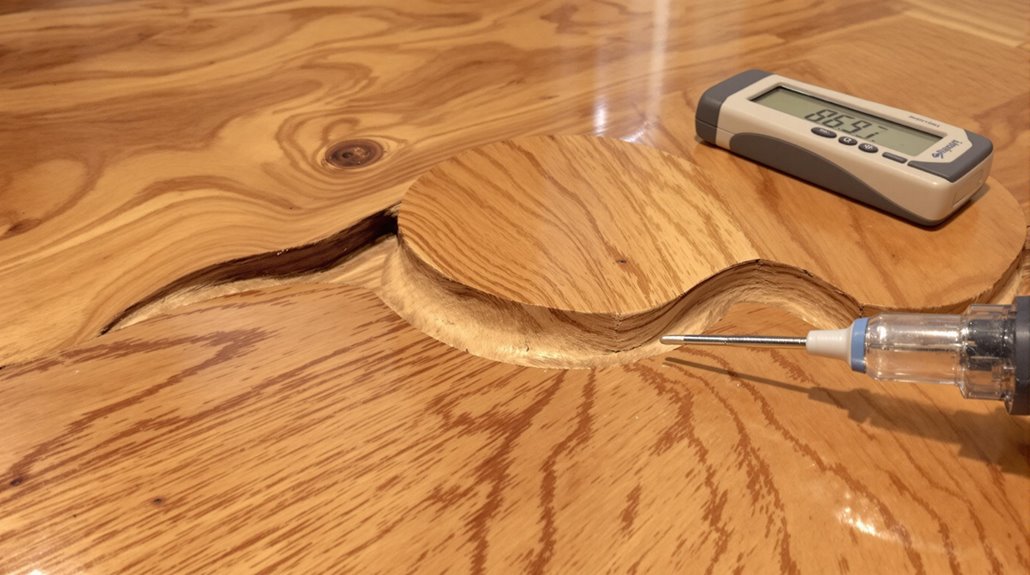
Proper moisture measurement begins with using both pin-type and pinless meters to gather thorough data about moisture distribution throughout the flooring system.
Testing should focus on areas near walls, under windows, around plumbing fixtures, and other locations prone to moisture intrusion, while maintaining consistent testing patterns across the floor surface.
Moisture levels typically stabilize when multiple readings taken over several days show consistent values within acceptable ranges for the specific wood species and when environmental conditions remain steady.
Using Moisture Meters Properly
Understanding how to properly measure moisture content in hardwood flooring requires familiarity with different types of moisture meters and their specific applications.
Pin-type meters measure electrical resistance by inserting probes into the wood, while pinless meters use electromagnetic waves to scan surfaces without causing damage. Proper moisture meter calibration is essential for accurate readings.
Effective moisture testing techniques involve measuring under controlled conditions, with ambient humidity between 30% and 50% and temperatures from 60 to 80 degrees Fahrenheit.
When using pin-type meters, operators must align pins with the wood grain for accurate measurements. Pinless meters require slow, deliberate movement across surfaces to maintain consistent contact.
Both types should be used to compare moisture levels between hardwood flooring and subfloor, ensuring readings fall within the acceptable 2% to 4% differential range.
Common Problem Areas Testing
Moisture content testing in hardwood floors requires systematic evaluation of common problem areas where cupping frequently occurs. Key moisture sources include basements, crawl spaces, and areas near plumbing fixtures, while exterior walls and HVAC systems can also contribute to moisture imbalances.
Professional floor inspections utilize both pinless and hammer probe moisture meters to assess damage at various depths.
Testing protocols involve mapping affected areas with dielectric meters, taking multiple readings across the floor surface, and comparing results to established EMC charts. Inspectors must examine both the hardwood flooring and subfloor, particularly in areas showing visual signs of warping or water damage.
This thorough assessment helps identify the root causes of cupping, whether from seasonal humidity fluctuations, water infiltration, or improper installation practices.
When Moisture Levels Stabilize
Once hardwood floors begin to stabilize from moisture-related cupping, professional assessment requires systematic measurement using both pin-type and pinless moisture meters to evaluate the extent of damage.
Effective moisture stabilization techniques involve monitoring multiple points across the flooring surface while implementing humidity control methods to maintain ideal conditions.
Key steps in the stabilization process include:
- Taking measurements from 40 boards per 1,000 square feet to establish baseline moisture content
- Maintaining room temperature between 60°F to 80°F with relative humidity at 30-50%
- Ensuring moisture content remains within 2-4% of subfloor readings
- Continuously monitoring seasonal variations using moisture meters until equilibrium moisture content is achieved
This systematic approach helps determine whether natural correction is possible or if professional intervention is necessary.
Professional Vs DIY Repair Methods
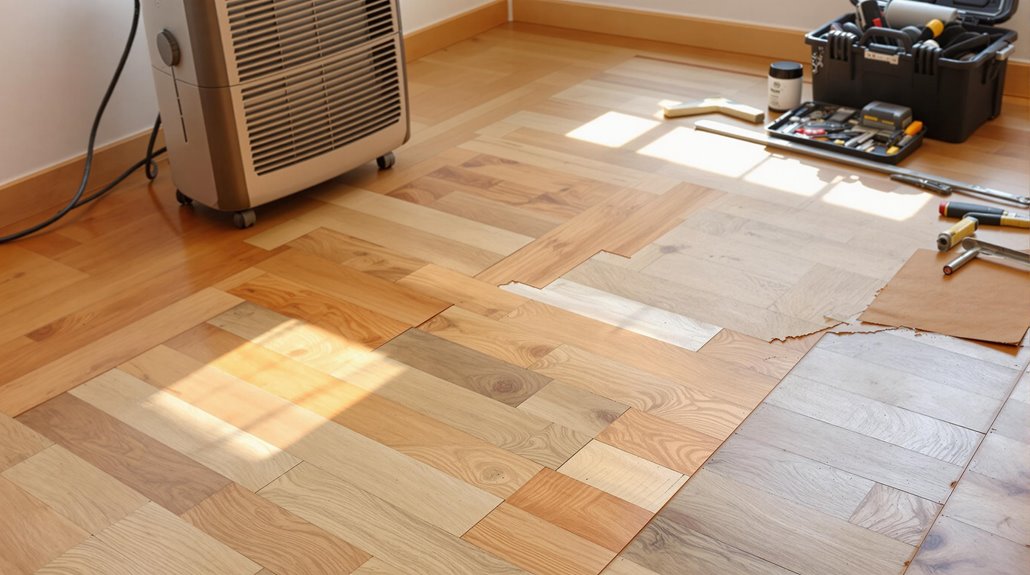
When faced with hardwood floor cupping, homeowners must carefully weigh the merits of professional repair services against do-it-yourself methods.
Professional repair services offer specialized equipment, expert damage assessment, and precise remediation techniques backed by warranties. Professionals utilize industrial dehumidifiers and professional-grade sanding machines while applying their knowledge to identify and address moisture sources effectively.
DIY limitations include restricted access to professional equipment, potential over-sanding risks, and inadequate expertise in moisture source identification.
While DIY approaches may appear cost-effective initially, they often require significant time investment and tool purchases.
The severity of cupping, available equipment, and long-term maintenance needs should guide the decision-making process.
Professional repairs typically provide thorough solutions with ongoing support, whereas DIY methods may compromise results due to limited expertise and equipment constraints.
Steps to Fix Cupped Hardwood Floors
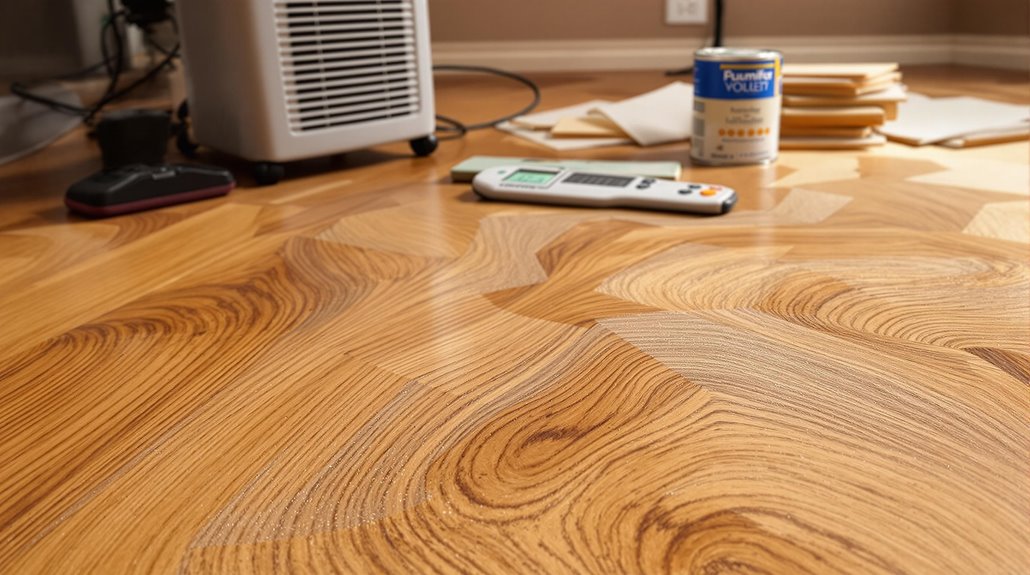
Whether choosing professional services or DIY methods, fixing cupped hardwood floors requires a systematic, multi-step approach to restore the flooring's integrity.
Effective moisture control begins with identifying and eliminating water sources, followed by implementing proper flooring maintenance procedures to prevent future damage.
The essential steps for addressing cupped floors include:
- Measure moisture content using specialized meters and establish proper ventilation and dehumidification systems.
- Allow for gradual drying while monitoring moisture levels until they return to 6-9%.
- Sand the floor using progressive grit levels, starting with 36-grit and working up to 120-grit.
- Apply multiple coats of urethane finish, allowing adequate drying time between applications.
For severe cases where significant warping persists, board replacement may be necessary to achieve ideal results.
Prevention Strategies and Maintenance Tips
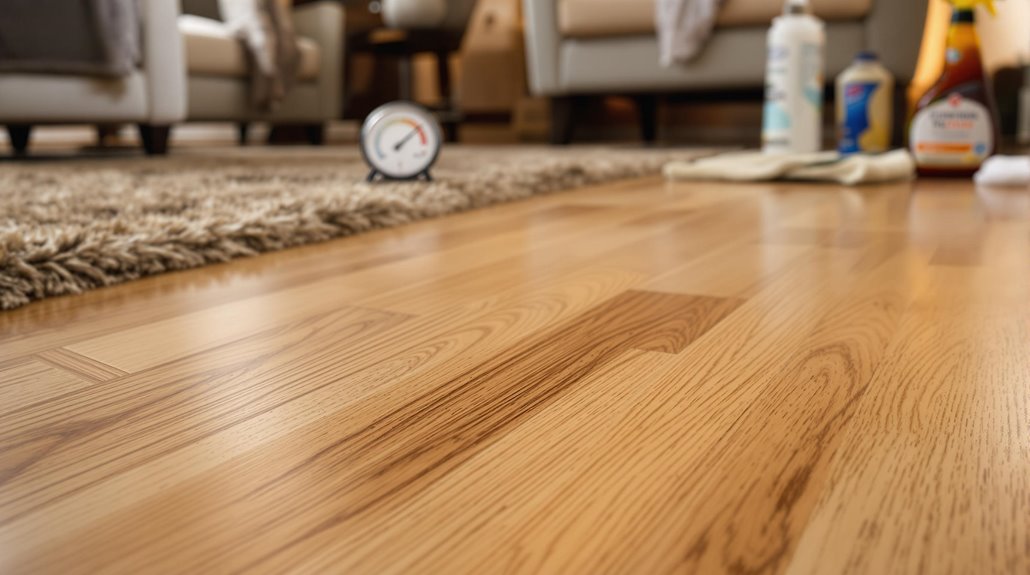
Maintaining hardwood floors in ideal condition requires a thorough approach that combines preventive measures with regular maintenance routines. Implementing proper humidity control stands as a critical preventive strategy, with homeowners needing to maintain relative humidity levels between 30% and 50% through the use of humidifiers and dehumidifiers.
Daily care involves using appropriate cleaning products specifically designed for hardwood surfaces while avoiding harsh chemicals or excessive water exposure.
A detailed maintenance plan includes regular dusting with microfiber tools, prompt attention to spills, and the strategic placement of protective elements such as area rugs and felt protectors under furniture.
Seasonal adjustments to humidity levels, coupled with consistent monitoring using a hygrometer, help prevent wood expansion and contraction that can lead to cupping.
Repair Costs and Time Expectations
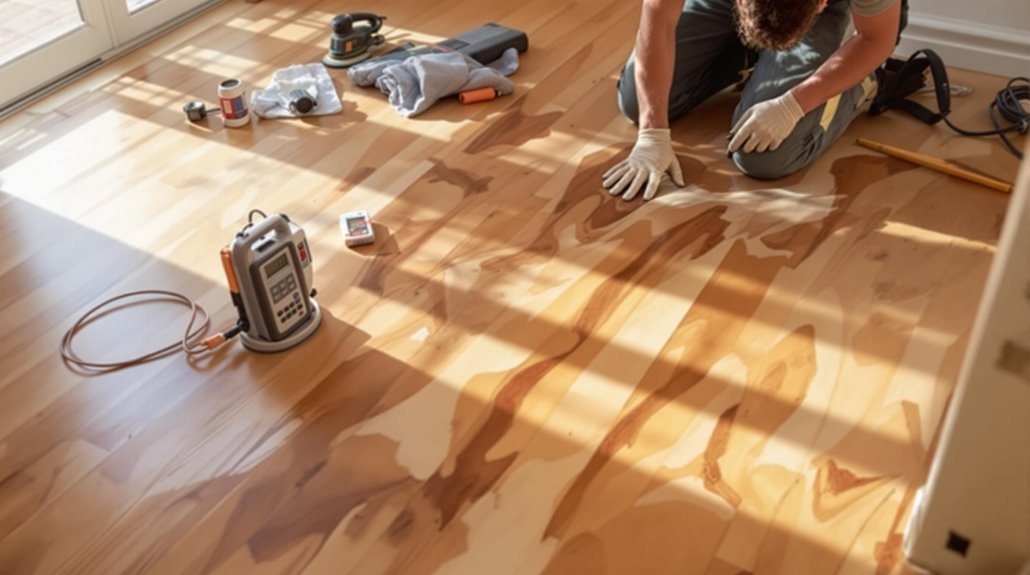
While proper maintenance helps prevent hardwood floor cupping, understanding the financial implications and timeline of repairs becomes necessary when issues arise.
Repair pricing varies greatly based on damage severity and scope, with typical costs ranging from $3 to $8 per square foot for standard cupping repairs, while severe water damage can reach $100 per square foot. Labor rates typically fall between $50 and $100 per hour.
Key repair considerations include:
- Project duration spans 5-20 hours, with additional time needed for drying and finishing.
- Total costs generally range from $250 to $2,000 for most repair projects.
- Moisture source identification and remediation may add $150-$400 to overall expenses.
- Complete restoration requires multiple phases: drying, sanding, and refinishing, each adding several days to the timeline.
Long-Term Solutions for Floor Stability
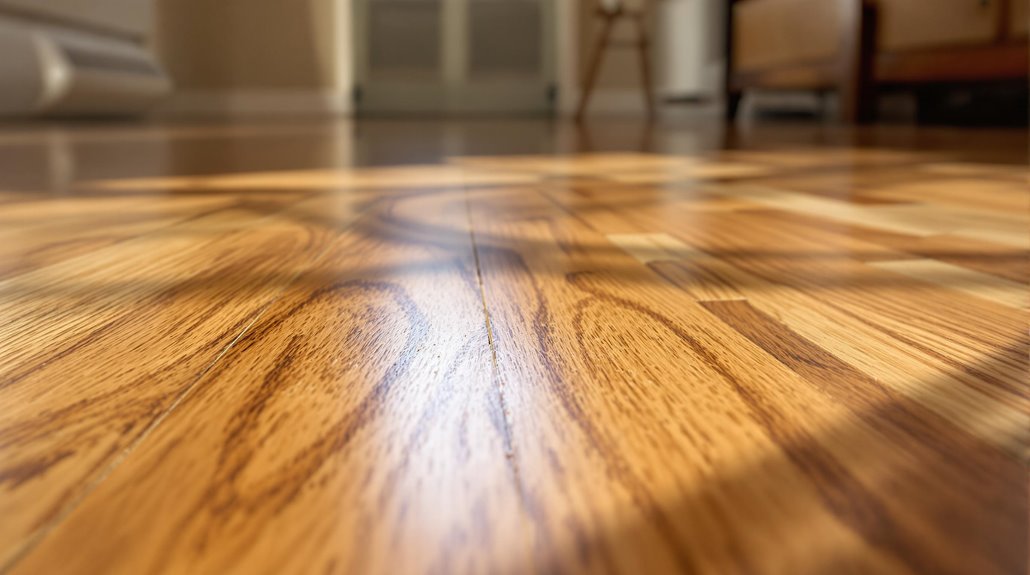
To guarantee long-term stability of hardwood floors, property owners must implement thorough solutions that address moisture control, proper installation techniques, and ongoing maintenance protocols.
Key strategies include installing proper moisture barriers during the initial installation phase and guaranteeing adequate floor ventilation throughout the structure.
The selection of dimensionally stable wood species, such as antique heart pine or American cherry, greatly reduces the risk of future cupping issues.
For maximum stability, engineered hardwood flooring presents an excellent alternative, as its layered construction provides superior resistance to moisture-related movement.
Maintaining indoor humidity levels between 35-55% through consistent climate control proves essential for preventing wood expansion and contraction.
Regular inspections and prompt addressing of any moisture sources further guarantee the longevity and stability of hardwood flooring installations.
The Benefits Of Consulting A Public Adjuster

For homeowners facing hardwood floor cupping issues, consulting a public adjuster can greatly enhance insurance claim outcomes through their specialized expertise in damage assessment and policy interpretation.
Public adjusters provide objective evaluations of floor damage while managing all aspects of the claims process, from documentation to negotiations with insurance providers. Their involvement often results in substantially higher settlement amounts, with statistics showing up to 700% greater compensation compared to claims filed without professional representation.
Engaging a licensed public adjuster quickly after discovering floor damage is crucial for maximizing claim success and preventing potential complications.
Expertise In Insurance Claims
Professional guidance from a public adjuster can greatly impact the outcome of hardwood floor cupping insurance claims. Their expertise in insurance policy interpretation and claim negotiation strategies guarantees extensive coverage for water-damaged flooring.
Public adjusters work independently to represent homeowners' interests, providing unbiased damage assessments and detailed documentation of all affected areas.
Key advantages of their expertise include:
- Thorough understanding of complex policy language and coverage limitations specific to water damage
- Expert documentation of visible and hidden damage patterns in hardwood flooring
- Strategic negotiation skills to counter low settlement offers from insurance companies
- Knowledge of local building codes and restoration requirements for proper floor repairs
This specialized knowledge often results in higher settlement amounts and faster claim resolution, allowing homeowners to proceed with necessary repairs promptly.
Operating on a contingency fee basis, public adjusters typically charge 5-20% of the final settlement amount, making their services accessible to homeowners seeking professional claims assistance.
Objective Damage Assessment
Independent assessment of hardwood floor cupping damage provides homeowners with essential unbiased documentation needed for successful insurance claims.
Public adjusters facilitate this process by conducting thorough moisture assessment and detailed damage documentation, ensuring all aspects of floor deterioration are properly recorded.
These professionals utilize their expertise to identify underlying moisture sources, evaluate the extent of cupping, and determine appropriate repair methodologies.
Their objective analysis helps establish accurate repair cost estimates while strengthening the homeowner's position during insurance negotiations.
Working exclusively for the property owner, public adjusters navigate complex claims processes, communicate effectively with insurance providers, and advocate for fair compensation.
Their independent perspective proves invaluable in securing extensive coverage for both immediate repairs and potential long-term remediation needs.
Unlike insurance adjusters who may provide profit-driven assessments, public adjusters work solely to maximize settlement amounts for the property owner.
Streamlined Claim Process
Many property owners discover that consulting a public adjuster greatly streamlines the hardwood floor cupping claims process through thorough management of documentation, negotiations, and settlement procedures.
These licensed professionals provide expert guidance while handling all aspects of the claim, allowing property owners to focus on recovery.
Public adjusters deliver value through:
- Extensive claim documentation compilation, including detailed damage assessments, repair estimates, and supporting evidence
- Implementation of proven negotiation strategies to secure fair settlements from insurance carriers
- Expert interpretation of policy coverage and application of relevant insurance regulations
- Efficient coordination of inspections, documentation reviews, and settlement discussions
Their specialized knowledge guarantees accurate representation of damages while expediting the claims process, ultimately helping property owners receive appropriate compensation for hardwood floor cupping repairs.
With settlement rates typically 15-30% higher than self-managed claims, hiring a public adjuster can lead to significantly better financial outcomes for property owners.
Higher Claim Payouts & Settlements
Statistical evidence consistently shows that property owners who engage public adjusters for hardwood floor cupping claims achieve markedly higher settlement amounts compared to those who handle claims independently. Through expert negotiation and extensive claim strategies, public adjusters leverage their specialized knowledge of insurance policies to identify all covered damages and secure maximum compensation.
| Claim Aspect | Public Adjuster Advantage |
|---|---|
| Assessment | Thorough documentation of visible and hidden damage |
| Negotiation | Strategic countering of insurance company tactics |
| Settlement | Higher payouts through policy expertise |
Their systematic approach includes detailed damage assessment, precise documentation, and skilled negotiations with insurers. This expertise proves particularly valuable in hardwood floor cupping cases, where damage patterns can be complex and restoration costs substantial. Public adjusters ascertain all aspects of the damage are properly evaluated and claimed, preventing undervaluation of repairs. With independent repair estimates from trusted contractors, public adjusters can more effectively challenge low settlement offers from insurance companies.
About The Public Claims Adjusters Network (PCAN)
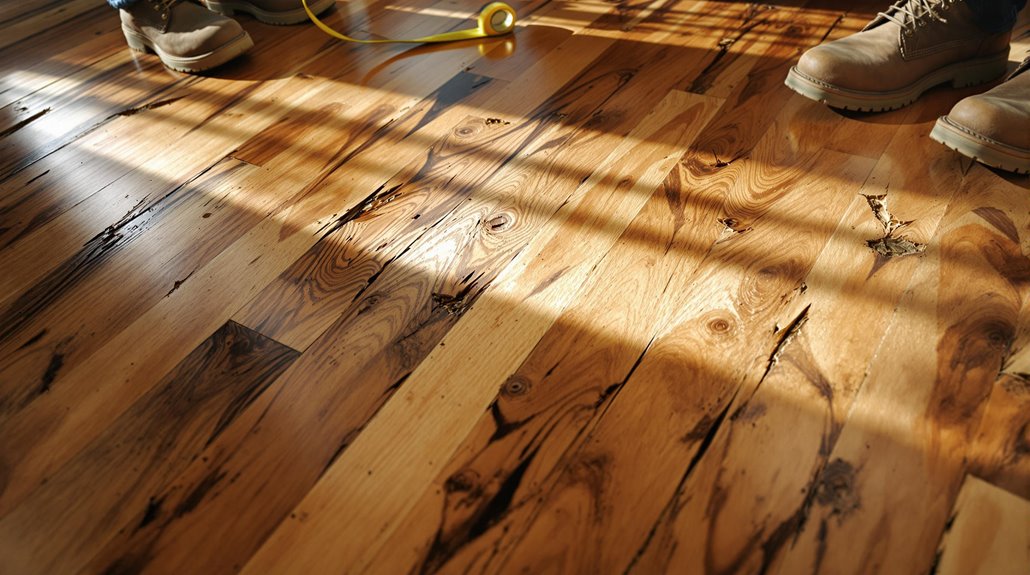
Networks of public claims adjusters, such as the Public Claims Adjusters Network (PCAN), function similarly to established organizations like NICA, providing extensive claims management solutions through a coordinated group of licensed professionals.
These networks deliver thorough Claims Representation services while offering Public Adjuster Benefits through their collective expertise and resources.
Key advantages of working with adjuster networks include:
- Access to over 40 years of industry-leading claims management expertise
- Tailored solutions that address specific challenges in hardwood floor damage claims
- Streamlined communication with insurance companies through established protocols
- Professional support from experienced adjusters who understand construction and repair requirements
These networks maintain strict compliance with regulatory requirements while leveraging their combined experience to secure ideal outcomes for policyholders facing hardwood floor cupping issues.
Frequently Asked Questions
Can Cupped Hardwood Floors Be Installed Over Radiant Heating Systems?
Proper flooring installation over radiant heating requires correcting cupping issues first. Once stabilized, engineered hardwood is recommended, with moisture barriers and temperature controls maintaining surface temperatures below 82°F.
Does Insurance Typically Cover Hardwood Floor Cupping Damage?
Insurance coverage typically extends to sudden, accidental water damage causing cupping, requiring professional damage assessment. Long-term moisture issues or gradual seepage generally remain excluded from standard homeowners policies.
How Does Seasonal Temperature Change Affect Already-Cupped Hardwood Floors?
Seasonal humidity and temperature fluctuations can intensify existing cupping by causing additional expansion and contraction cycles, potentially worsening the floor's deformation if moisture balance and environmental controls aren't maintained.
Can Certain Wood Species Resist Cupping Better Than Others?
Dense wood species with natural moisture resistance, like Cedar and Redwood, demonstrate superior cupping resistance due to their stable grain patterns and inherent chemical compounds that prevent moisture absorption.
What's the Minimum Thickness Needed for Sanding Cupped Hardwood Floors?
Safe sanding techniques require a minimum wood thickness of 3/32 inch above the tongue. For engineered hardwood, a 3/16-inch wear layer allows 1-2 refinishes, while solid hardwood needs 3/4 inch.
References
- https://www.fromtheforest.com/blogs/fromtheforest/floor-cupping-what-you-need-to-know
- https://www.wagnermeters.com/moisture-meters/wood-info/can-wood-floor-cupping-be-fixed/
- https://www.springcarpets.com/blog/articles/understanding-hardwood-floor-cupping-causes-effects-and-solutions
- https://blog.cityfloorsupply.com/how-to-fix-hardwood-floor-problems-cupping-crowning-chatter/
- https://www.quickshinefloors.com/how-to-fix-hardwood-floor-cupping/
- https://artisanwoodfloorsllc.com/hardwood-flooring-blog/what-is-cupping-in-hardwood-floors-causes-prevention-and-solutions/
- https://www.wagnermeters.com/moisture-meters/wood-info/spotting-trouble-hardwood-floors/
- https://www.builddirect.com/blogs/expert-advice-on-flooring/what-is-peaking-buckling-and-cupping-in-wood-floors
- https://www.firstatlantaflooring.com/news/hardwood-floor-cupping-what-is-it-and-how-can-you-fix-it/
- https://infinityfloorssussex.com/wood/understanding-wood-floor-cupping/
